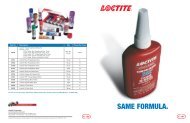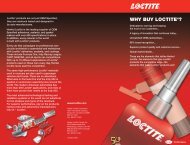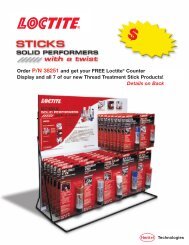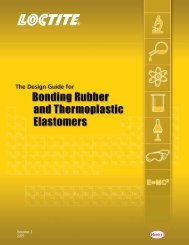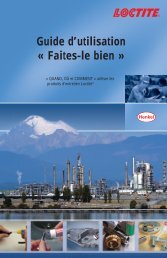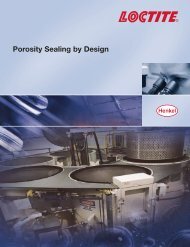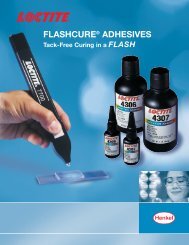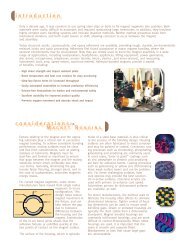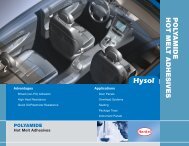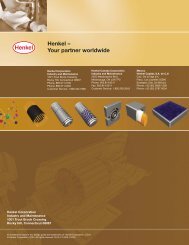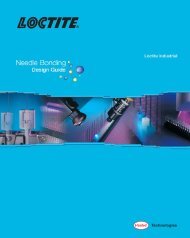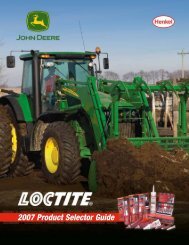Polyvinyl Chloride (PVC)ThermoplasticTrade Names• Al<strong>ph</strong>a• Fiberloc• Geon• Novablend• Polyvin• Quirvil• Superkleen• Tenneco• Unichem• VytheneManufacturerDexter PlasticsB. F. GoodrichB. F. GoodrichNovatec PlasticsA. SchulmanRukmianca SpAAl<strong>ph</strong>a ChemicalRimtech CorporationColorite PlasticsAl<strong>ph</strong>a ChemicalGeneral DescriptionPolyvinyl chloride, the most widely used of the vinyl resins, is formedvia the free radical polymerization of vinyl chloride monomer.Unmodified PVC is a hard, brittle, glass-like material which isunsuitable for most engineering applications. However, the additionof plasticizers, such as dioctyl <strong>ph</strong>thalate (DOP), give PVC sufficientflexibility to be used for many applications. PVC is one of the mosteconomical and versatile plastics in use today. It has become a verypopular construction material, with major applications includingpiping and home siding. Specialty grades available include impactmodified, filled, pigmented, and flame retarded. In 2004, the pricesof PVC ranged approximately from $0.60 to $1.50 per poundat truckload quantities.General PropertiesPolyvinyl chloride offers good <strong>ph</strong>ysical properties at a fraction of thecost of some of the more expensive engineering resins. A widevariety of fillers and additives are commonly used with PVC to tailorits characteristics to meet the needs of the end user. PVC is resistantto water, weathering and corrosion, has a high strength-to-weightratio, and is a good electrical and thermal insulator. Most grades ofPVC are non-flammable and receive a UL94 rating of V-0. With amaximum recommended continuous service temperature no higherthan 220°F (104°C), PVC is not recommended for high temperatureapplications. It has good resistance to alcohols, mild acids andbases, and salts, but is attacked by halogenated hydrocarbons,<strong>ph</strong>enols, ketones, esters, and ethers. PVC is easily processed by awide variety of thermoplastic methods, however, stabilizers must beadded to scavenge the HCl released during high temperatureprocessing which could degrade the resin.Typical Properties of Polyvinyl Chloride (PVC)American EngineeringProcessing Temperature 315°F to 410°F 157°C to 210°CLinear Mold Shrinkage 0.001 to 0.005 in./in. 0.001 to 0.005 cm/cmMelting Point 270°F to 405°F 132°C to 207°CDensity 72.4 to 91.8 lb./ft. 3 1.16 to 1.47 g/cm 3Tensile Strength, Yield 1.3 to 7.4 lb./in. 2 x 10 3 0.9 to 5.2 kg/cm 2 x 10 2Tensile Strength, Break 1.1 to 7.4 lb./in. 2 x 10 3 0.8 to 5.2 kg/cm 2 x 10 2Elongation, Break 5.0 to 500.0% 5.0 to 500.0%Tensile Modulus 2.7 to 4.5 lb./in. 2 x 10 5 1.9 to 3.2 kg/cm 2 x 10 4Flexural Strength, Yield 10.7 to 12.0 lb./in. 2 x 10 3 7.5 to 8.4 kg/cm 2 x 10 2Flexural Modulus 3.0 to 5.4 lb./in. 2 x 10 5 2.1 to 3.8 kg/cm 2 x 10 4Compressive Strength 6.5 to 10.1 lb./in. 2 x 10 3 4.6 to 7.1 kg/cm 2 x 10 2Izod Notched, R.T. 0.3 to 17.6 ft.-lb./in. 1.6 to 95.0 kg cm/cmHardness A50 - A95 Rockwell A50 - A95 RockwellThermal Conductivity 1.0 to 1.3 BTU-in./hr.-ft. 2 -°F 0.14 to 0.19 W/m-°KLinear ThermalExpansionDeflection Temperature@ 264 psiDeflection Temperature@ 66 psiContinuousService Temperature3.6 to 7.3 in./in.-°F x 10 -5 6.5 to 13.1 cm/cm-°C x10 -5SI100°F to 311°F 38°C to 155°C113°F to 311°F 45°C to 155°C130°F to 220°F 54°C to 104°CDielectric Strength 350 to 725 V/10 -3 in. 1.4 to 2.8 V/mm x 10 4Dielectric Constant@ 1 MHzDissipation Factor@ 1 MHzWater Absorption,24 hr.3.9 to 5.2 3.9 to 5.20.019 to 0.090 0.019 to 0.0900.08 to 0.60% 0.08 to 0.60%Typical Applications• Construction – Water supply, agricultural irrigationand chemical processing piping, siding, window sashes,gutters, interior moldings, flooring• Packaging – Films for food wrap, bottles, food containers• Consumer goods – Furniture parts, wall coverings,u<strong>ph</strong>olstery, sporting goods, toys• Medical – Tubing, blood and solution bags,dialysis devices, connectors68The <strong>Loctite</strong> ® Design Guide for Bonding Plastics, <strong>Volume</strong> 4
ADHESIVE SHEAR STRENGTH(psi)(MPa)Polyvinyl ChlorideUNFILLED RESIN3 rmsROUGHENED27 rmsUV STABILIZER1% UV-531IMPACT MODIFIER7% Paraloid BTA753FLAME RETARDANT0.3% Antimony OxideSMOKE SUPPRESSANT0.3% AmmoniumOctamolybdateLUBRICANT1% Calcium Stearate24-46FILLER% OmyaCarb FPLASTICIZER5% Drapex 6.8COLORANT0.5% FD&C Blue #1Oxychem 160 produced by Occidental ChemicalANTISTATIC1.5% Markstat AL48<strong>Loctite</strong> ® 380 Black Max ® Instant Adhesive,Rubber Toughened<strong>Loctite</strong> ® 401 Prism ® Instant Adhesive,Surface InsensitiveMEDICAL: <strong>Loctite</strong> ® 4011 Prism ®Instant Adhesive, Surface Insensitive<strong>Loctite</strong> ® 401 Prism ®<strong>Loctite</strong> ® 770 Prism ® PrimerMEDICAL: <strong>Loctite</strong> ® 4011 Prism ® /<strong>Loctite</strong> ® 7701 Prism ® Primer<strong>Loctite</strong> ® 414 Super Bonder ®Instant Adhesive, General Purpose<strong>Loctite</strong> ® 330 Depend ® Adhesive,Two-Part No-Mix Acrylic<strong>Loctite</strong> ® 3105 Light Cure Adhesive,MEDICAL: <strong>Loctite</strong> ® 3311 Light Cure Adhesive<strong>Loctite</strong> ® 3340 Light Cure Adhesive,UV Cationic Epoxy<strong>Loctite</strong> ® 4305 Flashcure ® Light Cure AdhesiveFLUORESCENT: <strong>Loctite</strong> ® 4307 Flashcure ®Light Cure Adhesive<strong>Loctite</strong> ® H3000 Speedbonder Structural Adhesive, General Purpose<strong>Loctite</strong> ® H4500 Speedbonder Structural Adhesive, Metal Bonder<strong>Loctite</strong> ® 3030 Adhesive, Polyolefin Bonder<strong>Loctite</strong> ® E-00CL Hysol ® Epoxy Adhesive,Low Odor<strong>Loctite</strong> ® E-90FL Hysol ® Epoxy Adhesive,Flexible<strong>Loctite</strong> ® E-30CL Hysol ® Epoxy Adhesive,Glass BonderMEDICAL: <strong>Loctite</strong> ® M-31CL Hysol ®Epoxy Adhesive, Glass Bonder<strong>Loctite</strong> ® E-20HP Hysol ® Epoxy Adhesive,Fast SettingMEDICAL: <strong>Loctite</strong> ® M-21HP Hysol ®Epoxy Adhesive, Fast Setting<strong>Loctite</strong> ® E-214HP Hysol ® Epoxy Adhesive,High Strength<strong>Loctite</strong> ® Fixmaster ® High Performance Epoxy<strong>Loctite</strong> ® 1942 Hysol ® Hot Melt Adhesive,EVA Based<strong>Loctite</strong> ® 3651 Hysol ® Hot Melt Adhesive,Polyolefin<strong>Loctite</strong> ® 7804 Hysol ® Hot Melt Adhesive<strong>Loctite</strong> ® 3631 Hysol ® Hot Melt Adhesive,Urethane<strong>Loctite</strong> ® U-05FL Hysol ® Urethane Adhesive,High Strength<strong>Loctite</strong> ® Fixmaster ® Rapid Rubber RepairOEM: <strong>Loctite</strong> ® U-04FL Hysol ®Urethane Adhesive, Fast Setting<strong>Loctite</strong> ® 5900 ® Flange Sealant,Heavy Body RTV Silicone>1600 >1600 >1600 >1100 >1600 1250>11.0 >11.0 >11.0 >7.6 >11.0 8.6>1600 >1600 >1600 >1600 >1600 >11.0 >11.0 >11.0 >11.0 >11.0 >3650 >1850 >2800 >4300 >3050 >3650 >3650 >4250 >2250 >3650 >3650 >25.2 >12.8 >19.3 >29.7 >21.0 >25.2 >25.2 >29.3 >15.5 >25.2 >25.2 >2850 >1400 >1400 >3650 >2850 >2850 >2850 >1750 >1550 >2850 >1200 >19.7 >9.7 >9.7 >25.2 >19.7 >19.7 >19.7 >12.1 >10.7 >19.7 >8.3 >2900 >20.0 >2900 >20.0 >2900 >20.0 >2900 >20.0 >2900 >20.0 >2900 >20.0 >2900 >20.0 >4400 >30.3 >2900 >20.0 >2900 >20.0 >2900 >20.0 >2650 >1550 >1850 1050 >2050 >1800 >1900 >2650 >1500 >1050 >900 >18.3 >10.7 >12.8 7.2 >14.1 >12.4 >13.1 >18.3 >10.3 >7.2 >6.2 >2550 >2550 >2550 >3000 >2550 >2550 >2550 >3150 >2550 >2550 >2550 >17.6 >17.6 >17.6 >20.7 >17.6 >17.6 >17.6 >21.7 >17.6 >17.6 >17.6 9506.6>2800 >19.3 235016.29006.2145010.04002.8160011.013509.32501.7NOTTESTED7004.83002.11000.71501.0>4300 >29.7 8505.910507.21501.0Adhesive Performance<strong>Loctite</strong> ® 380 Black Max ® , 401 Prism ® and 414 Super Bonder ® Instant Adhesives, <strong>Loctite</strong> ® 330 Depend ® Adhesive, and <strong>Loctite</strong> ® 4305 Flashcure ® and 3105 Light Cure Adhesives all created bondswhich were stronger than the rigid PVC substrate for most of the formulations tested. Excellent bondstrength was also obtained on PVC by <strong>Loctite</strong> ® H3000 Speedbonder Structural Adhesive, <strong>Loctite</strong> ® 3030 Adhesive, <strong>Loctite</strong> ® E-90FL and E-30CL Hysol ® Epoxy Adhesives, <strong>Loctite</strong> ® 3631 Hysol ® Hot MeltAdhesive and <strong>Loctite</strong> ® Fixmaster ® Rapid Rubber Repair.Surface TreatmentsSurface roughening and/or the use of <strong>Loctite</strong> ® 770 or 7701 Prism ® Primers resulted in either nostatistically significant effect or in the rigid PVC failing at a statistically significant lower bond strengththan the untreated PVC.Other Important Information• PVC can be stress cracked by uncured cyanoacrylate adhesives, so any excess adhesiveshould be removed from the surface immediately.• PVC is compatible with acrylic adhesives, but can be attacked by their activators before the adhesivehas cured. Any excess activator should be removed from the surface of the PVC immediately.• PVC is incompatible with anaerobic adhesives.• Surface cleaners: isopropyl alcohol, <strong>Loctite</strong> ® ODC-Free Cleaner & Degreaser.NOTES: The force applied to the tests specimens exceededthe strength of the material resulting in substrate failurebefore the actual bond strength achieved by theadhesive could be determined.NOT TESTED: Substrate melted at adhesivecure temperature.The addition of the indicated additive (or surfaceroughening) caused a statistically significant decrease inthe bond strength within 95% confidence limits.The addition of the indicated additive (or surfaceroughening) caused a statistically significant increase inthe bond strength within 95% confidence limits.The <strong>Loctite</strong> ® Design Guide for Bonding Plastics, <strong>Volume</strong> 4 69



